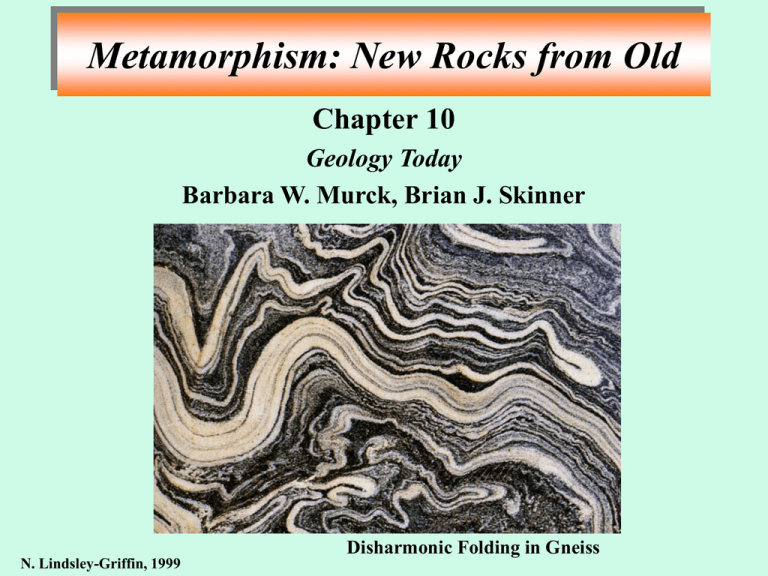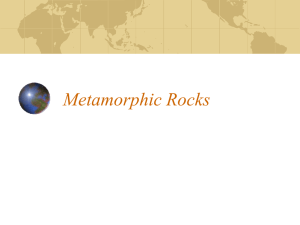
Metamorphism: New Rocks from Old
Chapter 10
Geology Today
Barbara W. Murck, Brian J. Skinner
Disharmonic Folding in Gneiss
N. Lindsley-Griffin, 1999
Rock Cycle
Metamorphic
Rock
Rock formed in the
solid state by
alteration of
preexisting rock deep
within the Earth.
Heat, pressure, and
chemically active
fluids are the agents.
J. R. Griffin, 1999
Metamorphism
Mineralogical, chemical, and structural changes in solid
rocks, in response to physical and chemical conditions at
depths below regions of sedimentation and diagenesis.
N. Lindsley-Griffin, 1999
Fig. 10.2, p. 273
Metamorphism
Pressure, temperature are the most important factors.
N. Lindsley-Griffin, 1999
Metamorphic Factors
PORE FLUIDS
Small amounts of gases or liquids
between grains
Facilitate solution, migration, and
precipitation of ions to speed up
recrystallization
Provide a reservoir for ions during
the growth of new minerals
Speed up reactions
Fig. 10.3, p. 274
Quartz veins in slate
N. Lindsley-Griffin, 1999
Metamorphic Factors
PRESSURE
1. Confining pressure:
greater density, prevents
fracture, plastic
deformation
2. Differential stress: Nonuniform pressure produces
preferred orientation, rock
cleavage, foliation
Fig. 10.4, p. 275:
Gneiss formed in
differential stress
N. Lindsley-Griffin, 1999
Granite formed in uniform stress
Metamorphic Factors
HEAT
Enhances
recrystallization
Speeds up chemical
reactions
At deepest crustal
levels, some of the
rock melts
Migmatite - part metamorphic
and part igneous
(Fig. 10.9, p. 281)
N. Lindsley-Griffin, 1999
Metamorphic Factors
TIME - enhances all other metamorphic factors
Long periods of time allow larger grains to grow
N. Lindsley-Griffin, 1999
Slate
Protolith: shale
Low grade
Gneiss
Protolith: shale
High grade
Metamorphic Factors
LARGE AMOUNTS OF FLUIDS
= METASOMATISM
Composition changes greatly by:
- addition of new material
- removal of old material
- combination of both
Fig. 10.20, p. 291:
Limestone changed into
red garnet, green pyroxene,
and calcite rock.
If pure, would be marble.
N. Lindsley-Griffin, 1999
Metamorphic Factors
LARGE AMOUNTS OF FLUIDS
= METASOMATISM
Composition changes greatly by:
- addition of new material
- removal of old material
- combination of both
Fig. 10.20, p. 291:
Limestone changed into
red garnet, green pyroxene,
and calcite rock.
If pure, would be marble.
N. Lindsley-Griffin, 1999
Preferred orientation:
All the seagulls are facing into or away from the wind
This alignment produces a foliation
N. Lindsley-Griffin, 1998
Foliation:
From conglomerate to
metaconglomerate flattened cobbles parallel
to each other
Alluvial sandstone
and conglomerate
Metaconglomerate, Fig. 10.5, p. 276
N. Lindsley-Griffin, 1998
Foliation:
Slaty cleavage tendency to
break along
planes that form
perpendicular to
maximum stress.
In folded layers
the cleavage
parallels the axial
plane
N. Lindsley-Griffin, 1999
Slaty cleavage at angle to bedding
Fig. 10.7, p. 277
Foliation:
Schistosity - planar
minerals like mica
crystallize
perpendicular to
maximum stress.
Garnet Schist
Thin section view of
schistosity in phyllite
N. Lindsley-Griffin, 1999
Foliation:
Gneiss - micaceous
schist alternating with
coarsely crystalline
bands
Pre-existing layers
High-grade
metamorphism
N. Lindsley-Griffin, 1999
Low Grade to High Grade
Progressive
changes to shale
as higher T and
P over time
allow different
index minerals
to form.
Fig. 10.8, p. 280
N. Lindsley-Griffin, 1999
Types of Metamorphism
CONTACT
METAMORPHISM
Rocks are heated and
chemically changed
by intrusion of hot
magma.
Concentric zones or
aureoles
N. Lindsley-Griffin, 1999
Types of Metamorphism
BURIAL METAMORPHISM - Deep sedimentary basins
REGIONAL METAMORPHISM - Subduction
and plate collision; most intense where continents collide
Affects broad regions
Mountain ranges and
continental interiors
Fig. 10.12, p. 283
N. Lindsley-Griffin, 1999
Types of Metamorphism
METASOMATISM
Very large water-rock ratios
Composition changes greatly by:
- addition of new material
- removal of old material
- combination of both
Fig. 10.20, p. 291:
Limestone changed into
red garnet, green pyroxene,
and calcite rock.
If pure, would be marble.
N. Lindsley-Griffin, 1999
Metamorphic Facies
INDEX MINERAL - appears
at certain P-T conditions in
the progression from lower
grade to higher grade:
Chlorite
Biotite
Garnet
Kyanite
Sillimanite
ISOGRADS - lines on map
showing where a particular
index mineral first appears.
Fig. 10.13, p. 284
N. Lindsley-Griffin, 1999
Metamorphic Facies
Assemblage of minerals typical of a set of metamorphic conditions
Fig. 10.14, p. 285
N. Lindsley-Griffin, 1999
Metamorphic Facies
Polymorphs of Al2SiO5 reveal P-T conditions
Kyanite
Sillimanite
Andalusite
Fig. 10.14, p. 285, with additions
N. Lindsley-Griffin, 1999
Regional metamorphism
Continental core regions -Canadian Shield
N. Lindsley-Griffin, 1998
Regional metamorphism
Finely foliated rocks: slate and phyllite.
Slate, with slaty cleavage at high angle to bedding
N. Lindsley-Griffin, 1998
Regional metamorphism
Coarsely foliated rocks: Schist
Micaceous minerals, formed from shale or siltstone
N. Lindsley-Griffin, 1998
Regional metamorphism
Coarsely foliated rocks: Gneiss
Bands of micaceous minerals alternating with bands of granular
minerals (usually quartz and feldspar)
N. Lindsley-Griffin, 1998
Shear Metamorphism
Along faults - grinding and crushing at shallow crustal levels,
stretching and recrystallization at deeper levels. Also known as
cataclastic metamorphism (not in textbook).
Mylonite Thin section
N. Lindsley-Griffin, 1998
Metamorphic Rocks
Foliated
Protolith + Process = Product
Greenschist
Amphibolite
Basalt + moderate T and P = greenschist (green chlorite)
Basalt + high T and P = amphibolite (black amphibole)
N. Lindsley-Griffin, 1999
Fig. 10.16, p. 288
Metamorphic Rocks
Foliated
Protolith + Process = Product
Basalt + low T, high P = Blueschist (blue amphibole)
Blueschist + high T and P = Eclogite (green pyroxene, red garnet)
(Fig. 10.17, p. 288)
N. Lindsley-Griffin, 1999
Metamorphic Rocks
Foliated
Protolith + Process = Product
Shale
Slate
Phyllite
Schist, Gneiss
Increasing metamorphic grade
Fig. 10.8, p. 280
N. Lindsley-Griffin, 1999
Metamorphic Rocks
Foliated
Protolith + Process = Product
Shale + heat, pressure
Slate
Phyllite
with progressive growth of foliation, grain size
(Fig. 10.15, p. 287)
N. Lindsley-Griffin, 1999
Metamorphic Rocks
Foliated
Protolith + Process = Product
Phyllite
N. Lindsley-Griffin, 1999
Schist (clay-rich)
Gneiss (quartz + feldspar rich)
Metamorphic Rocks
Nonfoliated
Protolith + Process = Product
Hand specimen of Quartzite
Thin section of Quartzite
Quartz sandstone + Recrystallization = Quartzite
N. Lindsley-Griffin, 1999
Fig. 10.19, p. 290
Metamorphic Rocks
Nonfoliated
Protolith + Process = Product
Hand specimen of Marble
Thin section of Marble
Limestone + Recrystallization = Marble
N. Lindsley-Griffin, 1999
Fig. 10.19, p. 290
Metamorphic Facies at
Convergent Boundaries
High temperature,
low pressure
in volcanic arcs
Greenschist and
Amphibolite facies
High pressure,
low temperature
in subduction zone
Greenschist and
Blueschist facies
© Houghton Mifflin 1998. All rights reserved
Metamorphism at Convergent Boundaries
Regional
Contact
Shear
© Houghton Mifflin 1998. All rights reserved
Metamorphism at Mid-Ocean Ridges
Sea water circulates
in fractures
Water is heated,
hydrothermally
changes basalt
Metals are
concentrated
near hot vents
© Houghton Mifflin 1998. All rights reserved
Metamorphism at Divergent and
Transform Boundaries
Divergent:
Hydrothermal
Shear
© Houghton Mifflin 1998. All rights reserved
Transform:
Shear








